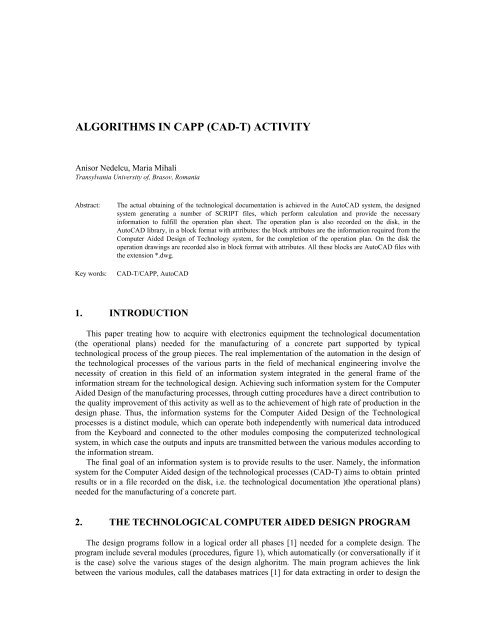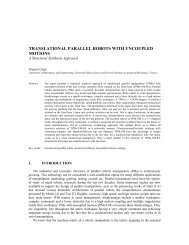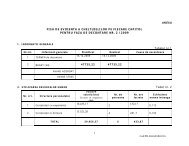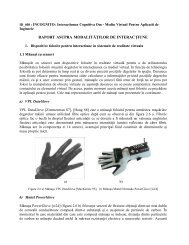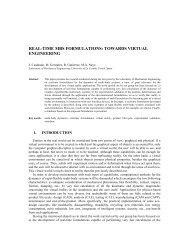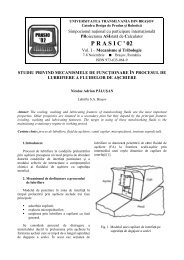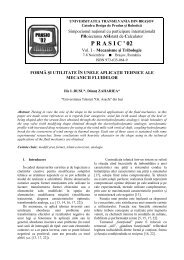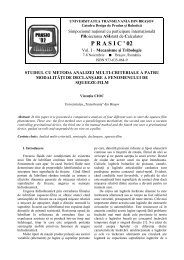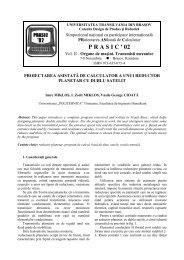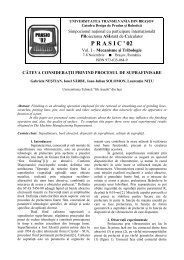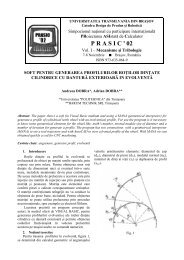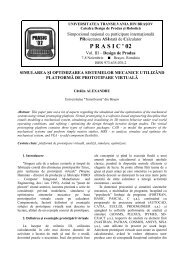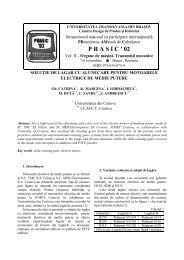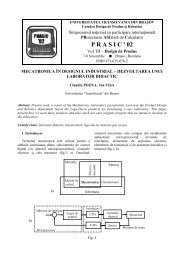ALGORITHMS IN CAPP (CAD-T) ACTIVITY
ALGORITHMS IN CAPP (CAD-T) ACTIVITY
ALGORITHMS IN CAPP (CAD-T) ACTIVITY
Create successful ePaper yourself
Turn your PDF publications into a flip-book with our unique Google optimized e-Paper software.
<strong>ALGORITHMS</strong> <strong>IN</strong> <strong>CAPP</strong> (<strong>CAD</strong>-T) <strong>ACTIVITY</strong><br />
Anisor Nedelcu, Maria Mihali<br />
Transylvania University of, Brasov, Romania<br />
Abstract:<br />
Key words:<br />
The actual obtaining of the technological documentation is achieved in the Auto<strong>CAD</strong> system, the designed<br />
system generating a number of SCRIPT files, which perform calculation and provide the necessary<br />
information to fulfill the operation plan sheet. The operation plan is also recorded on the disk, in the<br />
Auto<strong>CAD</strong> library, in a block format with attributes: the block attributes are the information required from the<br />
Computer Aided Design of Technology system, for the completion of the operation plan. On the disk the<br />
operation drawings are recorded also in block format with attributes. All these blocks are Auto<strong>CAD</strong> files with<br />
the extension *.dwg.<br />
<strong>CAD</strong>-T/<strong>CAPP</strong>, Auto<strong>CAD</strong><br />
1. <strong>IN</strong>TRODUCTION<br />
This paper treating how to acquire with electronics equipment the technological documentation<br />
(the operational plans) needed for the manufacturing of a concrete part supported by typical<br />
technological process of the group pieces. The real implementation of the automation in the design of<br />
the technological processes of the various parts in the field of mechanical engineering involve the<br />
necessity of creation in this field of an information system integrated in the general frame of the<br />
information stream for the technological design. Achieving such information system for the Computer<br />
Aided Design of the manufacturing processes, through cutting procedures have a direct contribution to<br />
the quality improvement of this activity as well as to the achievement of high rate of production in the<br />
design phase. Thus, the information systems for the Computer Aided Design of the Technological<br />
processes is a distinct module, which can operate both independently with numerical data introduced<br />
from the Keyboard and connected to the other modules composing the computerized technological<br />
system, in which case the outputs and inputs are transmitted between the various modules according to<br />
the information stream.<br />
The final goal of an information system is to provide results to the user. Namely, the information<br />
system for the Computer Aided design of the technological processes (<strong>CAD</strong>-T) aims to obtain printed<br />
results or in a file recorded on the disk, i.e. the technological documentation )the operational plans)<br />
needed for the manufacturing of a concrete part.<br />
2. THE TECHNOLOGICAL COMPUTER AIDED DESIGN PROGRAM<br />
The design programs follow in a logical order all phases [1] needed for a complete design. The<br />
program include several modules (procedures, figure 1), which automatically (or conversationally if it<br />
is the case) solve the various stages of the design alghoritm. The main program achieves the link<br />
between the various modules, call the databases matrices [1] for data extracting in order to design the
320 Anisor Nedelcu, Maria Mihali<br />
technological process for a concrete part manufactured with cutting technology from a part group or<br />
class and record all the obtained information for a late ruse.<br />
The program is writing in TurboPASCAL 6.0 language. The main program structure is very<br />
simple, as following:<br />
BEG<strong>IN</strong><br />
Header; Page 1;<br />
Screen; General Data;<br />
CaseldProc; Addition;<br />
Int-dim; Speed;<br />
TimeNorm; RegenScr;<br />
END.<br />
Figure 1. The main program structure<br />
The main program makes simple calls of the various procedures (modules). A short description of<br />
the utilized procedures is given below:<br />
a) Header, Pagel1.Screen, RegenScr are procedures for the display area gestations in text mode; they<br />
interface the user to the computer, making, and a „user-friendly” environment. It is generally<br />
accepted that the fashion of a program is very important for as commercial success.<br />
b) General Data is the procedure allowing the taking over the general input deformation regarding the<br />
concrete part.<br />
c) CaseldProc is the procedure which materializes the case identification process [1] and within the<br />
surface information is taken over with their complete geometric description, including the precision<br />
and the quality of manufacturing. This procedure returns the technological process for the concrete<br />
part (the technology matrix type 2) selected from type technology process (the technology matrix<br />
type 1).<br />
d) Addition, Int-Dim is procedures which solve the problem of manufacturing supplements<br />
determining and of the intermediate technological dimensions.<br />
e) Speed is the procedure which solves the problem of cutting condition parameters determining.<br />
f) TimeNorm is the procedure which determines the technical norm of time<br />
g) Printer is the procedure for the printer administration, in order to print a document containing some<br />
data needed for marking the technological dimensions on the operation drawings.<br />
h) Edit is the procedure for the postprocessor, which do not anything else but generate a series of<br />
SCRIPT files (*.scr), containing the data to be recorded in the operation plan sheet; for each<br />
operation a separate SCRIPT file is generated.<br />
To use in practice systems based on such programs all parts being in manufacturing in a given<br />
Company must be classified in parts groups or classes depending on the geometrical shape and<br />
dimensions. For each class or group of parts a complex part must be selected or designed for the<br />
manufacturing of which the type technological process must be used [1].<br />
From the type technological process of the complex part which represents a class or a group, the<br />
program selects the operations needed to manufacture a concrete part, with the indication of the<br />
manufacturing methods, tools utilized, the cutting speed, the technical norm of time etc.<br />
For a better understanding of the diagram from the figure 2, as well as of the application programs<br />
chain, a description of the algorithm for database utilization is given hereafter:
Algorithms in <strong>CAPP</strong> (<strong>CAD</strong>-T) activity 321<br />
– Identification of the type technology matrix using the surface code surface quality and precision<br />
class marked on the execution drawing.<br />
Figure 2. A description of the algorithm for database utilization<br />
– Selecting the technological method or procedure corresponding to the respective manufacturing<br />
process.<br />
– Machine tool identification with the related data.<br />
– Using the data selected from the other matrices the manufacturing supplement is calculated and the<br />
intermediate technological dimensions, the cutting speed parameters and the technical norm of<br />
time. The calculated data or taken over during the matrices during the process are recorded in the<br />
second part of the type technology matrix. The record will be located at the same position on which<br />
the surface was identified.<br />
– Comparison between the surface codes from the type technology matrix according the type of<br />
manufacturing. This latter type will be that in which the quality surface and precision are greater<br />
and the position are to be identified (number, operation number, phase number).<br />
– The alghoritm stages are iteratively replayed beginning from the point 2.<br />
– The process continues for the same surface until the greater values for the dimensional surface<br />
quality and precision are found.<br />
– The input program is loaded and the next surface data are introduced.<br />
– The alghoritm is replayed from the beginning for each surface composing the concrete part from a<br />
group for which the technological process with cutting tools is designed.<br />
The results of the program package running are recorded in the second part of the type technology<br />
matrix. By exploiting this matrix the operation plan can be derive don the printer.
322 Anisor Nedelcu, Maria Mihali<br />
3. ACQUIREMENT OF THE TECHNOLOGICAL DOCUMENTATION<br />
As already stated, the information is carried throughout the system in a numerical code format. The<br />
results provided by the system are also coded in a numerical format. This code is usually decrypted<br />
only by dedicated computer procedures or experienced programmers. In the next stage a postprocessing<br />
phase is needed in order to prepare the technological documents in the usual format, i.e.<br />
translation from the computer numerical format to the natural language easily understood. The postprocessing<br />
work is performed using the processor (the post-processor), embedded into the procedure<br />
EDIT, presented in [1].<br />
As presented in [1], the system has a core element the technology type matrix. All needed<br />
information to edit the technological documentation for a given part manufacturing with cutting tools<br />
are provided by this matrix. The only needed operation is decoding and then recording in the usual<br />
table on the manufacturing plan sheet. The way in which the information is recorded from the type<br />
technology matrix in the manufacturing plan sheet is the following: using the surface code introduced<br />
through the input procedure of the initial data, the type technology matrix derived and the surface<br />
position is recorded, the operation number, phase number, operation title, the manufactured surface<br />
title etc).<br />
Using the surface position previously identified a procedure or method is searched for the<br />
technological process according to the manufacturing type. For this procedure all features are taken<br />
into consideration: the procedure code, the procedure title, the machine tool code, preparatory-ending<br />
time, the necessary data for the technical norm of time calculation (for the technological procedures or<br />
methods of manufacturing for which there is no any mathematical model for calculating the technical<br />
norm of time) such as: auxiliary time, supply time, organizational time, resting time, the number of<br />
parts simultaneously/successively manufactured etc. Also, using the procedure code and the machine<br />
type code, the machine tool type is identified and all characteristic data are selected: the machine tool<br />
name, producer, the machine tool code etc.<br />
For this operation of the manufacturing process for the respective surface, using the data selected<br />
from the other matrix during the process 2, 3 the manufacturing supplement and the intermediate<br />
dimensions are calculated as well as the cutting conditions parameters, the technical norm of time and<br />
likely the manufacturing cost. These technological data are taken from the second part of the type<br />
technology matrix. Using the surface code the technology group matrix is searched, the cutting tool<br />
address, the auxiliary tool address, the manufacturing device address and the dimensional check<br />
device address. In this way the technology documentation is fulfilled for manufacturing part faces the<br />
cutting technology process of which is in fact designed.<br />
In the Auto<strong>CAD</strong> geometric modeler, deriving the manufacturing operations drawings for the<br />
surface is a very simple task if SCRIPT files are used. The numerical information of the drawing has<br />
been obtained following the previous calculations and the database exploring using a TurboPASCAL<br />
program. The SCRIPT file method is used when there is no need to keep the real proportions between<br />
the dimensions of the drawing (e.g. the drawings for the operation plan, the drawings for the adjusting<br />
sheets in case of automate lathe use, some drawings for calibrated tools etc) [1].<br />
The SCRIPT files contain Auto<strong>CAD</strong> commands which are successively executed, in an automatic<br />
way. These files are TXT files, in which the commands are recorded with respect to the usual syntax<br />
and operation order in Auto<strong>CAD</strong>. The SCRIPT files are recorded on the disk with a name and the<br />
extension “SCR”.<br />
A SCRIPT file may be created in an automatic way using a TurboPASCAL program: obviously,<br />
specific procedure are needed in order to process the numerical results and decisions obtained by the<br />
main design program (in our case the program for Computer Aided Design of Technology).<br />
The design program [1] decides what surfaces are manufactured at each operation. A SCRIPT file<br />
was created which to put into the operation plan sheet only those blocks corresponding to the results.<br />
The blocks library contains all possibly shapes which may be obtained, in each manufacturing<br />
operation (each operation correspond to a line). The blocks have the name coded in the following way:<br />
B + Operation Number (of the line in which the drawing is made, counted from the top to bottom) +
Algorithms in <strong>CAPP</strong> (<strong>CAD</strong>-T) activity 323<br />
the drawing position in the respective line. A matrix of the form [b ij ] is obtained, where, i-the<br />
operation number, j-the drawing position on the respective line.<br />
Figure 3. Acquirement of the technological documentation<br />
From the main program, the intermediate dimensions and corresponding block are obtained for<br />
each surface to be manufactured. These data are systematized in tables like the following model:<br />
Table 1. The systematized of intermediate dimension and corresponding block are obtained for each surface to be<br />
manufactured<br />
Operation Phase Surface Surface Block Dimensions<br />
number number group code type code position D13= L1= D11=<br />
10 1 1 01 4<br />
The SCRIPT file contains Auto<strong>CAD</strong> the necessary commands as well as the appropriate answers in<br />
the corresponding dialogues. These files are executed from the Auto<strong>CAD</strong> session with the command<br />
SCRIPT and the text lines are automatically executed one by one as Auto<strong>CAD</strong> is an interpreter based<br />
language. At the SCRIPT end file the control is returned to Auto<strong>CAD</strong>.<br />
Figure 4. The editing process of the technological documentation<br />
Because the files are in text format, they can be generated easily with a TurboPASCAL processor<br />
program. In conclusion, the editing processor only writes the output data in a precise established<br />
format and order. The editing process of the technological documentation is presented in figure 4.<br />
REFERENCES<br />
1. NEDELCU A., „Modele matematice, algoritmi si aplicaţii privind proiectarea asistată de calculator a proceselor<br />
tehnologice de prelucrare prin aşchiere”, Teza de doctorat, Universitatea Transilvania din Braşov, Romania.


